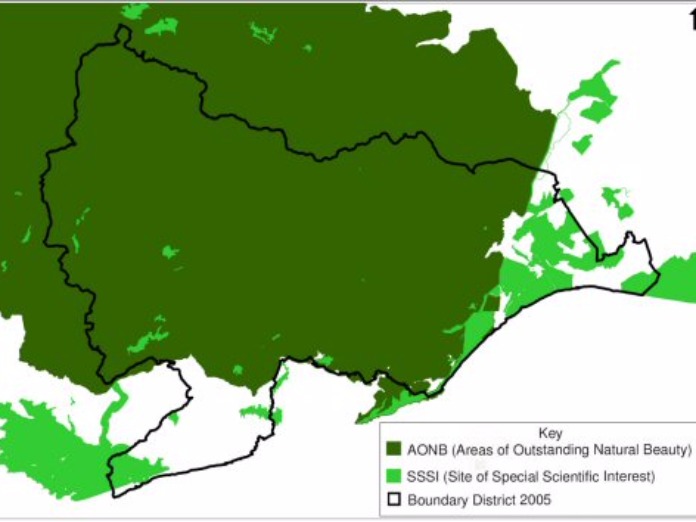On Thursday, January 14, Rother District Council (RDC)’s planning committee discussed new national planning guidelines and the requirement to increase land for housing across the district – and the need to re-write the local plan for the district.
The discussion was a result of RDC failing to get enough houses built, or supply sufficient land for future house building, to meet the ambitious targets set by central government. The committee heard that housing targets are likely to increase and that around 730 homes will need to be built in Rother each year, equating to about 7,300 over the next 10 years. This is about double the current level of houses being built.
The committee heard that if Rother does not reach its target then the government will enact sanctions and increase their housing delivery target by a further 20%. These targets have been applied across England, but have been criticised as being driven by an algorithm based on historical demand rather than by the amount of land available.
One of the key reasons why Rother has not met its housing target, councillors said, was because 90% of the district is either covered by an area of outstanding natural beauty (AONB) or has a site of special scientific interest (SSSI) designation (see map at top). Housing development is severely restricted in both areas to protect the countryside, but the knock-on effect is housing must then be concentrated in areas where housing is allowed – namely Bexhill and Rye.
Will neighbourhood plans be affected?
Rother’s predicament could in turn affect Rye’s neighbourhood plan. One councillor representing North Rother was damning, saying, “Neighbourhood plans no longer apply” and that neighbourhood plans are now “pointless”. The chair of the meeting, Councillor Jonathan Vine-Hall, was quick to disagree with these comments, saying that neighbourhood plans would still help guide planning applications within those areas that had them. They would also be used to help produce a new local plan for the whole of Rother – though this is expected to take two and a half years.
An additional problem expressed by the committee members was that the council is approving planning applications to build housing, but they cannot force the developers to go ahead and build them. The council said that they have already approved 2,800 homes but they do not have the powers to force the developers to build the houses.
Both Rye’s representatives on RDC, Councillor Rev Howard Norton and Councillor Gennette Stevens, attended the planning committee meeting but, as yet, it is unclear what this means for the future supply of housing in Rye, or how it will change the targets within the current neighbourhood plan. In any event, if the new government guidelines are to be applied to Rother as proposed, then it is likely there will be significant pressure for additional greenfield land around Rye to be made available for housing development. Our local planners have some thinking to do.
Image Credits: RDC: Core Strategy Consultation on Strategy Directions 2008 https://rother.oc2.uk/document/153 .




Interesting read on the housing debate, we have already seen both Rye town council, the conservation society,and the Rye neighbourhood plan, ignored by Rother, and East Sussex County Council, why people put themselves forward, for these posts,as they are sadly losing the battle, over money and greed.
Good article, Kevin, thank you. You make an excellent point that the AONB means that most development is being squeezed into the Rye and Bexhill areas. My view is that 736 extra homes a year in the Rother area is unsustainable, if local people wish to retain the green and open living environment they value so much. This scale of development — exemplified by the 63 homes planned for the old school site — will change Rye’s character and will also affect those people living in nearby villages, which are increasingly coming under unwanted development pressure.
It’s likely, sadly, that certain villages will soon become mere suburbs of Rye. The flooding risk that hangs over the town means development will inevitably target higher land on the Playden and Udimore Rd escarpments, distorting the compact shape of Rye and damaging the town’s historic character and open environment.
My understanding is that the proposed housing target for Rother was initially set at 1,173 homes (before being reduced to 736), compared to the previous target of 335. Actual houses being built in Rother each year currently total 245, so the government is forcing three times the amount of building development into two small areas (Rye and Bexhill). The situation is unsustainable, especially in the southeast of England, which already boasts the highest population density in the UK. The Covid-19 pandemic is accelerating an “urban exodus” as people flood out of cities and seek to move to smaller towns, villages and the countryside. The fact that no control on UK population growth exists — and there is no demographic plan — is the underlying reason for this planning and environmental chaos.
It’s pretty scandalous that Neighbourhood Plans such as Rye’s, which took years of effort to put together, are now under threat of being ignored. I also wonder how much time and resources RDC will require to draw up yet another Local Plan for our region. For everyone asking, “What can I do about all this?”, I’m afraid the only solution is to use your vote to change decision-making at the national and local levels.
Local people should perhaps note that their Parish Councils are often dominated by individuals who have skin in the development game. Many of these people do great work for their communities, and I thank them, but I simply point out that the nature of their occupations inevitably influences decisions they take on planning matters.